The small American town of Emmitsburg, Maryland (population 3,629), grew by approximately 50% on Thursday, June 6, when a crowd of up to 1,500 Catholics joined two Eucharistic processions on its usually quiet streets.
Emmitsburg is home to the National Shrine of St. Elizabeth Ann Seton, the first saint born in the United States. Rob Judge, the shrine’s executive director, noted that it was probably the largest gathering in the town since Mother Seton’s canonization in 1975.
Receive the main news from ACI Prensa by WhatsApp and Telegram
It is increasingly difficult to see Catholic news on social media. Subscribe to our free channels today:
“Seeing people flow and worship Our Lord and simply use this space to have an encounter with Him is humbling for all of us who are here every day,” he said.
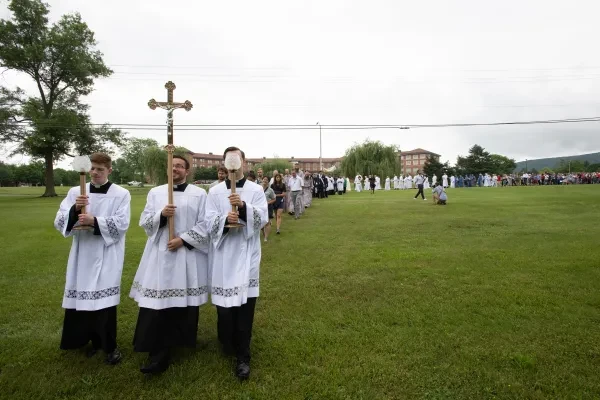
The processions through Emmitsburg and to neighboring Mount St. Mary’s University and Seminary are part of the National Eucharistic Pilgrimage, which is an initiative of the National Eucharistic Revival of the U.S. Catholic bishops, an effort to foster greater understanding and devotion to the mystery of Jesus in the Eucharist.
The pilgrimage began on Pentecost with four routes launched from the East and West coasts and the northern and southern borders of the nation. Almost every day for two months, the faithful from all over the country are joining Jesus in the Eucharist as he tours their cities and towns. All four routes converge in Indianapolis on July 16 for the National Eucharistic Congress.
The Seton Trail, which began in New Haven, Connecticut, and passed through Emmitsburg on Thursday, is named for the saint who is honored at the shrine. Zoe Dongas, one of the “Perpetual Pilgrims” who travel the entire route, expressed admiration for St. Elizabeth Ann Seton during events at the shrine.
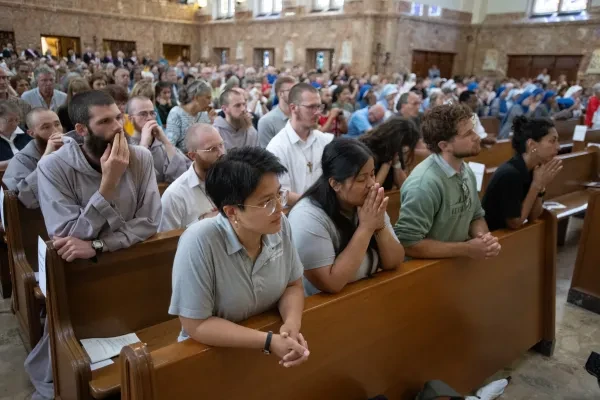
“Personally, I am very inspired by how Mother Seton, in her conversion and in her love for the Eucharist, was willing to bet everything on Jesus and the Eucharist and was willing to accept the social problems that would entail,” Dongas said.
Father Roger Landry, chaplain of the Seton Route, indicated that “beyond the physical resistance necessary, spiritual resistance is clearly needed.” The priest is accompanied by six “Perpetual Pilgrims,” who are accompanying Jesus in the Eucharist throughout the route.
“As a priest, I do a retreat every year… (but) that’s different than having the Lord Jesus two inches (5 cm) from your nose half the day. And so developing that spiritual resilience to not take for granted the incredible gift of overexposure is something we need to work on as well,” he continued.
According to the priest, experiencing the history of the Church and the beautiful basilicas, along with the large number of people who join the processions, has been an “overwhelmingly exciting” experience throughout the pilgrimage.
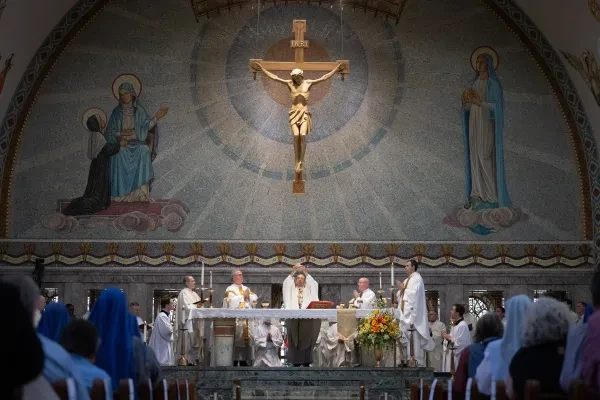
After a morning Mass at the Basilica of St. Elizabeth Ann Seton, Baltimore Archbishop William Lori led the procession outside, holding the monstrance aloft as priests, seminarians and faithful followed. At Mother Seton Catholic School—a girls’ elementary school founded by St. Elizabeth Ann Seton in 1810—the procession was greeted by a group of schoolchildren.
Children sang as the Eucharist was displayed for adoration. The 2.3 kilometer-long procession resumed, stopping to pray at two Catholic cemeteries.
Pilgrims prayed and sang hymns, guided by organizers who used a van with loudspeakers to lead attendees in prayers and songs. At the stops, many participants knelt on the grass or in the street to worship the Eucharist held in a monstrance, which was placed on an altar set up for the procession.
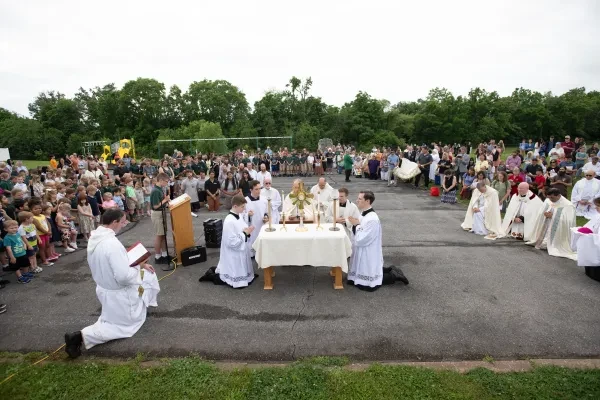
The Frederick County Sheriff’s Office temporarily blocked roads along the procession routes, causing a small traffic jam on the main street. Bishop Andrew Baker, rector of nearby Mount St. Mary’s Seminary, said he was “amazed by the number of people who came to worship (Christ), to be with Him, to praise Him.”
“I don’t think Emmitsburg has ever seen anything like it. “I tried my best to turn around and try to see the crowd and I couldn’t see the end of it,” he added.
The afternoon procession, which began at 1:30 p.m., was a longer—and more arduous—journey from Seton Shrine to the National Shrine of the Grotto of Our Lady of Lourdes. Still, hundreds of people stayed for the 3.5-mile uphill journey that Mother Seton and other Sisters of Charity nuns made in the early 1800s to attend Mass on St. Mary’s Mountain.
The pilgrims marched to reach the grotto. The route from Seton Shrine to the grotto has an elevation gain of approximately 228 meters. As the path became steeper towards the end of the journey, the procession began to slow before reaching the grotto sanctuary.

During the procession to the grotto, attendees sang hymns, prayed the luminous mysteries of the Rosary, and—as they began to slow down the steepest part—prayed the Litany of the Passion.
The priests celebrated the blessing in the sanctuary of the grotto. The sanctuary honors Our Lady of Lourdes with a replica of the grotto that was the site of the Marian apparitions in Lourdes, France, in 1858.
Although Emmitsburg is not near any major population areas, many people traveled from Maryland, as well as Pennsylvania and Virginia, to participate in the processions. An attendee from Maryland, Lora McMunn, told CNA – EWTN News’ English agency – that the procession was “amazing” and it was great to see families, young people and “seniors” all together for the processions.
“It is important that people come together with other people who share the faith and that we present ourselves to the world as Catholics… and show (people) that this is what (we) believe,” McMunn detailed.
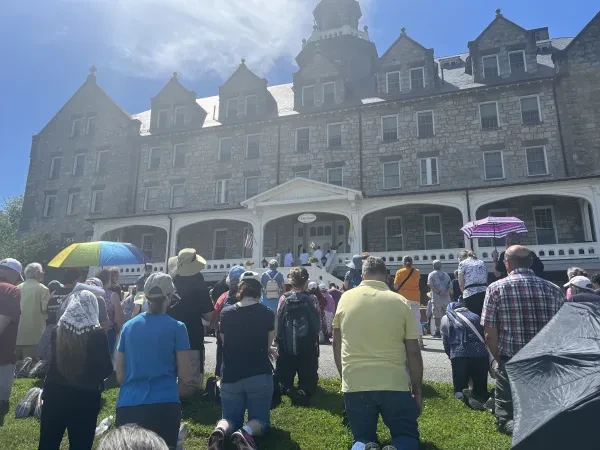
Who was Saint Elizabeth Anne Bayley Seton?
Elizabeth Ann Seton was born into a prominent Episcopal family in New York City in 1774, but converted to Catholicism in 1805, two years after her husband’s death. She had five children with her husband. The future saint moved to Maryland due to the strong Catholic presence in the state and the social stigma she faced in New York from her Episcopal friends and family following her conversion.
St. Elizabeth Ann Seton entered religious life and founded the Sisters of Charity of St. Joseph in Emmitsburg, Maryland, the first community of religious women to begin in the United States. She also founded the first free Catholic school for girls.
One of the driving forces behind Mother Seton’s conversion was her recognition of the real presence of Christ in the Eucharist, which she began to notice as she saw the strong Catholic devotion to the Blessed Sacrament.
The Mother Seton Shrine has a basilica, which houses about 850 people, and a newly opened museum, containing artifacts and personal writings of the saint. There are also historic buildings near the sanctuary.
The Seton Trail headed south to Baltimore and will head to the next procession in Washington, DC, on Saturday, June 8. After the procession in the nation’s capital, the pilgrimage will move into southwestern Pennsylvania, including Pittsburgh, before heading further west toward Ohio and its final destination in Indiana.
Translated and adapted by ACI Prensa. Originally published in CNA.

